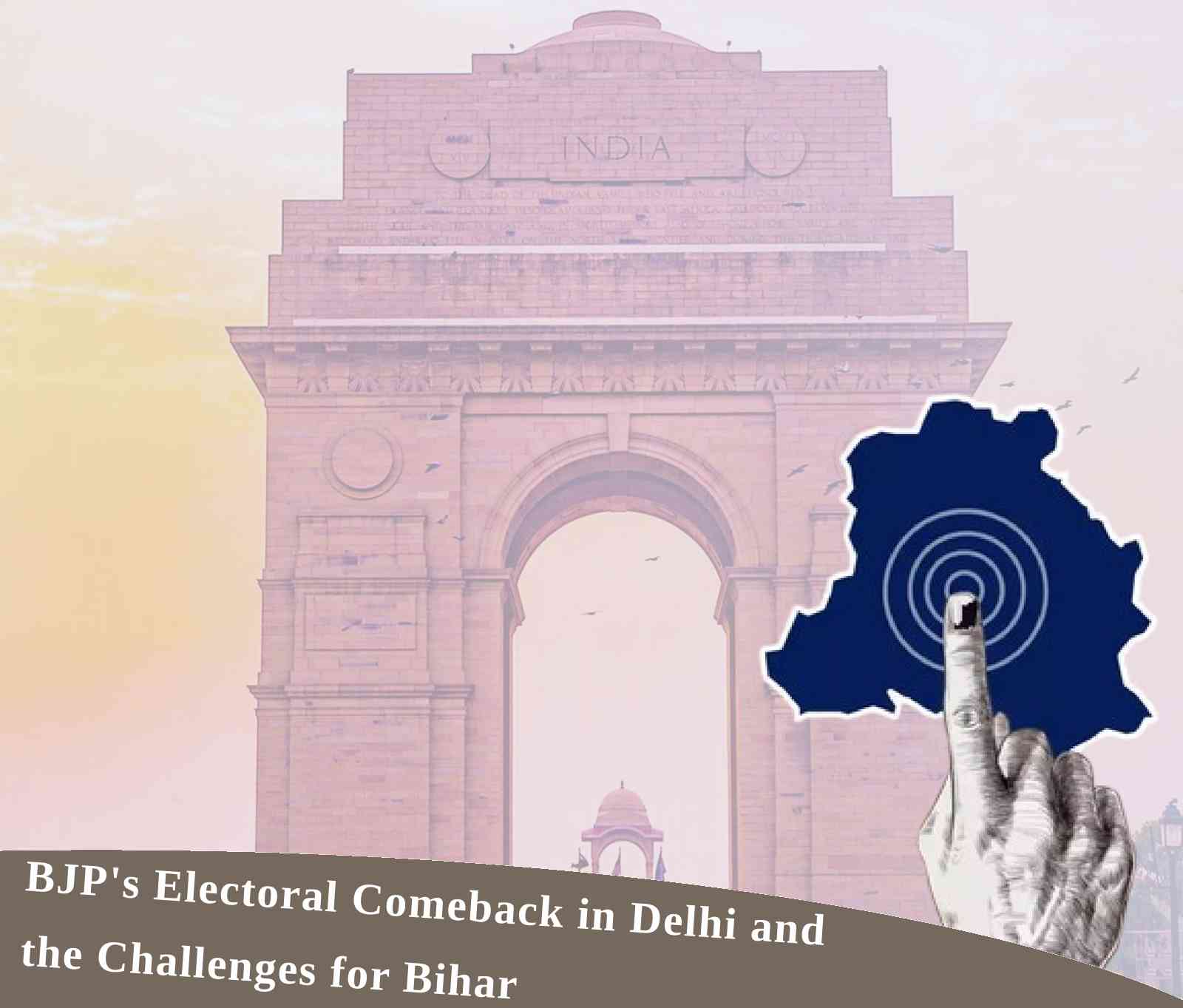BJP's Electoral Comeback in Delhi and the Challenges for Bihar

After winning thumping majorities in successive elections in 2015 and 2020, the AAP has now suffered a major defeat in 2025. A loss of nearly ten percentage points in vote share, from 53 to 43, has brought the AAP seat tally down to 22. The BJP's vote share has increased by seven percentage points from 38 to 45, causing its seat tally to jump sixfold from 8 to 48. This marks the BJP's return to power in the national capital after a long gap of twenty-seven years and the third Assembly election victory for the NDA after the BJP lost its independent majority in the 2024 Lok Sabha elections.
Several factors have contributed to this drastic change in Delhi. The BJP's desperation to grab power in Delhi had become crystal-clear in the 2020 elections when it ran a vicious campaign openly inciting communal violence to crush the citizenship movement. When this did not pay many immediate electoral dividends, the Modi government unleashed a virulent campaign of suppression of dissent. The spree of arrests of student activists, human rights campaigners and even opposition Councillors was followed by a campaign of political persecution against the AAP leadership with serial arrest of several leaders including Arvind Kejriwal and Manish Sisodiya, the CM and his deputy.
This politics of vendetta apart, the BJP resorted to a systematic encirclement of the AAP government by using the apparatus of the Union Government and the office of the Lieutenant Governor. Time was when the BJP too used to demand full statehood for Delhi, but to obstruct the AAP government, the BJP overrode the Supreme Court and drastically curtailed the powers of the Delhi government, virtually crippling it and reducing it to the level of a glorified municipality by passing the dubious Delhi Services Act (The Government of National Capital Territory Amendment Act, 2023). Added to this obstructive encirclement and erosion of the powers of the Delhi government was the clinical manipulation of Delhi's electoral roll, complete with selective deletion, inclusion and transfer of electors.
The BJP attempted a similar strategy in Jharkhand - Chief Minister Hemant Soren was arrested, the stopgap CM defected to the BJP and a toxic hate campaign was let loose in the name of electioneering to pit Adivasis against Muslims. The strategy however collapsed and the BJP got defeated for the second successive Assembly election. Why did the BJP strategy work in Delhi while it failed in Jharkhand? The answer partly lies in the way the opposition fought the elections in the two states. Jharkhand had a united anti-BJP camp and a spirited campaign in defence of the Constitution and the federal rights and aspirations of the state. Delhi had no unity within the INDIA bloc and the compelling political perspective of defeating the BJP's fascist offensive remained conspicuously missing in the election discourse.
There is also an evident decline in the popular appeal of AAP and the 'common man' image of Arvind Kejriwal. Two hundred units of free electricity and enhanced emphasis on improved public education do still have a positive resonance among the poor and lower middle class population of Delhi, but neglect of the demands of Delhi's working class, poor performance on delivery of municipal services and almost total silence on the question of suppression of democracy and promotion of hate in Delhi have weakened the active popular support that had fetched such overwhelming majorities for AAP in the two previous elections. The allegations of liquor scam and the Rs 33.6 crore renovation of the chief minister's bungalow considerably dented the clean and simple image of the AAP leadership and Kejriwal was in no position to pull off a victory around his fading public image.
The BJP's renewed total control over Delhi will pose a greater challenge for the common people and the whole gamut of progressive democratic forces and initiatives in the national capital. Hopefully the changed political landscape will foster a spirit of cooperation among the broad non-BJP political camp in Delhi beyond the limited framework of floor coordination in parliament. In terms of the all-India picture, all eyes will now be on Bihar, the only other election-bound state in 2025. In Delhi, the BJP had been out of power for the last 27 years and benefited from the popular disillusionment with AAP. In Bihar, the BJP has been in power in coalition with the JDU for most of the last twenty years and there is growing public anger against the all-round failure and betrayal of the BJP-JDU regime.
If a united opposition has been successful in stalling the BJP in Jharkhand, there is no reason why the same cannot happen in Bihar. With closer connect between the electoral battle and the wide-ranging struggles on the ground and more reasonable electoral understanding within the INDIA coalition, Bihar can stop the Maharashtra-Haryana-Delhi winning spree of the BJP and deliver a decisive blow to the Sangh brigade's fascist offensive. At a time when the Modi government is insulting the legacy of India's anti-colonial freedom movement by capitulating to the US and undermining the secular democratic character of the Constitution that emerged from the freedom movement, Bihar, which has historically been a key citadel of anti-colonial and anti-feudal struggles, must once again prove to be a bastion of the protracted battle for genuine democracy and social transformation.
Charu Bhawan, U-90, Shakarpur, Delhi 110092
Phone: +91-11-42785864 | +91 9717274961 E-mail: info@cpiml.org

